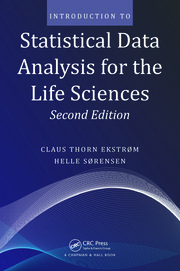Introduction to Statistical Data Analysis for the Life Sciences, 2nd ed

Summary
Any practical introduction to statistics in the life sciences requires
a focus on applications and computational statistics combined with a
reasonable level of mathematical rigor. It must offer the right
combination of data examples, statistical theory, and computing
required for analysis today. And it should involve R software, the
lingua franca of statistical computing.
Introduction to Statistical Data Analysis for the Life Sciences
covers all the usual material but goes further than other texts to
emphasize:
- Both data analysis and the mathematics underlying classical statistical analysis
- Modeling aspects of statistical analysis with added focus on biological interpretations
- Applications of statistical software in analyzing real-world problems and data sets
Developed from their courses at the University of Copenhagen, the
authors imbue readers with the ability to model and analyze data early
in the text and then gradually fill in the blanks with needed
probability and statistics theory. While the main text can be used
with any statistical software, the authors encourage a reliance on
R. They provide a short tutorial for those new to the software and
include R commands and output at the end of each chapter.
Each chapter contains a number of exercises, half of which can be
done by hand. The text also contains ten case exercises where readers
are encouraged to apply their knowledge to larger data sets and learn
more about approaches specific to the life sciences. Ultimately,
readers come away with a computational toolbox that enables them to
perform actual analysis for real data sets as well as the confidence
and skills to undertake more sophisticated analyses as their careers
progress.
Errata
A list of errata in the first printing can be found here
Datasets
The datasets used in the book are available as an R package and can be
found on CRAN. The package
documentation can be found
here. Install the package directly from CRAN using the following
command from within R:
> install.packages("isdals")
The individual datasets in ASCII format can be found below:
Figures
The figures from the book are available below (click on a thumbnail to
get the full-size image) and are still retained by copyright but
lecturers are free to use them in slides and presentations as long as
the book is referenced.
















































































































Example slides from lectures
More will appear from September 2010. The slides ending in
-en are from an English-version course using the book. All
other slides are in Danish.
claus@ekstroem.dk
















































































































